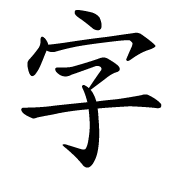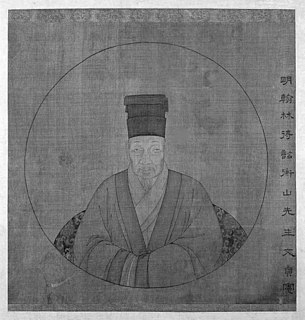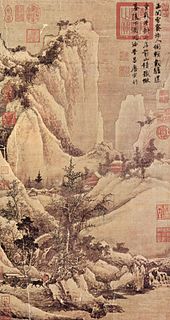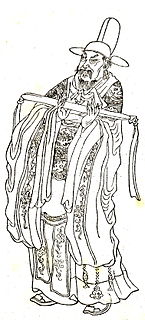
| Zhang Xu | |||||||||||||||||||
| Traditional Chinese | 張旭 | ||||||||||||||||||
|---|---|---|---|---|---|---|---|---|---|---|---|---|---|---|---|---|---|---|---|
| Simplified Chinese | 张旭 | ||||||||||||||||||
| |||||||||||||||||||
Zhang Xu (Chinese :張旭, fl. 8th century), courtesy name Bogao (伯高), was a Chinese calligrapher and poet of the Tang Dynasty.

Traditional Chinese characters are Chinese characters in any character set that does not contain newly created characters or character substitutions performed after 1946. They are most commonly the characters in the standardized character sets of Taiwan, of Hong Kong and Macau, and in the Kangxi Dictionary. The modern shapes of traditional Chinese characters first appeared with the emergence of the clerical script during the Han Dynasty, and have been more or less stable since the 5th century.

A courtesy name, also known as a style name, is a name bestowed upon one at adulthood in addition to one's given name. This practice is a tradition in the Sinosphere, including China, Japan, Korea, and Vietnam.
A native of Suzhou, he became an official during the reign of Emperor Xuanzong of Tang. Zhang was known as one of the Eight Immortals of the Wine Cup. Legend has it that whenever he was drunk, he would use his hair as brush to perform his art, and upon his waking up, he would be amazed by the quality of those works but failed to produce them again in his sober state.

Suzhou, formerly romanized as Soochow, is a major city located in southeastern Jiangsu Province of East China, about 100 km (62 mi) northwest of Shanghai. It is a major economic center and focal point of trade and commerce, and the second largest city in the province, after its capital Nanjing. The city is situated on the lower reaches of the Yangtze River and the shores of Lake Tai and belongs to the Yangtze River Delta region. Administratively, Suzhou is a prefecture-level city with a population of 4.33 million in its city proper, and a total resident population of 10.58 million in its administrative area. Its urban population grew at an unprecedented rate of 6.5% between 2000 and 2014, which is the highest among cities with more than 5 million people.

Emperor Xuanzong of Tang, also commonly known as Emperor Ming of Tang or Illustrious August, personal name Li Longji, also known as Wu Longji from 690 to 705, was the seventh emperor of the Tang dynasty in China, reigning from 713 to 756 C.E. His reign of 43 years was the longest during the Tang dynasty. In the early half of his reign he was a diligent and astute ruler. Ably assisted by capable chancellors like Yao Chong, Song Jing and Zhang Yue, he was credited with bringing Tang China to a pinnacle of culture and power. Emperor Xuanzong, however, was blamed for over-trusting Li Linfu, Yang Guozhong and An Lushan during his late reign, with Tang's golden age ending in the Anshi Rebellion.
The Eight Immortals of the Wine Cup or Eight Immortals Indulged in Wine were a group of Tang Dynasty scholars who are known for their love of alcoholic beverages. They are not deified and xiān is metaphorical. The term is used in a poem by Du Fu, as well as in the biography of Li Bai in the New Book of Tang.
Though more well known for his explosive cursive script, he excelled in the regular script. There is an anecdote that says he grasped the essence of cursive writing by observing some porters fight for their way with the guard of honor of some princess, and by watching the solo performance of a famous sword-dancer named Lady Gongsun (公孫大娘). He was known as 草聖 (the Divine Grassist) for his great skill in the grass script. [1]

Cursive script, often mistranslated as grass script, is a script style used in Chinese and East Asian calligraphy. Cursive script is faster to write than other styles, but difficult to read for those unfamiliar with it. It functions primarily as a kind of shorthand script or calligraphic style. People who can read standard or printed forms of Chinese or related scripts may not be able to comprehend this script.

Regular script, also called 正楷, 真書 (zhēnshū), 楷體 (kǎitǐ) and 正書 (zhèngshū), is the newest of the Chinese script styles, hence most common in modern writings and publications.
Under the excitement of art (and wine), he became oblivious of social expectations, and would often fling off his cap in the presence of princes and nobles. Hence he came to be known as 張顛 (Zhang the Madman). [1] He is often paired with the younger Huaisu as the two greatest cursive calligraphers of the Tang Dynasty. The duo is affectionately referred to as "the crazy Zhang and the drunk Su" (顛張醉素).

Huaisu, courtesy name Zangzhen (藏真), was a Buddhist monk and calligrapher of the Tang Dynasty, famous for his cursive calligraphy. Fewer than 10 pieces of his works have survived. One of his representative works is Huai Su's Autobiography.
One of Zhang Xu's poems was included in the poetry anthology Three Hundred Tang Poems .
The Three Hundred Tang Poems is an anthology of poems from the Chinese Tang dynasty (618–907) first compiled around 1763 by Sun Zhu (1722–1778), the Qing Dynasty scholar, also known as Hengtang Tuishi. Various later editions also exist. All editions contain slightly more than 300 total poems: in this case, three hundred means not exactly 300 but refers to an estimative quantification; the ten, twenty, or more extra poems represent a sort of a good luck bonus, analogous to the "baker's dozen" in the West. Even more, the number 300 was a classic number for a poetry collection due to the influence of the Classic of Poetry, which was generally known as The Three Hundred Poems.










